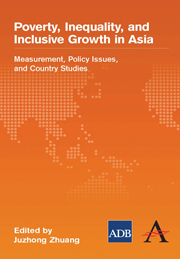Book contents
- Frontmatter
- Contents
- Foreword
- Preface and Acknowledgments
- Contributors
- Abbreviations, Acronyms, and Symbols
- Tables, Figures, and Boxes
- 1 Poverty, Inequality, and Inclusive Growth in Asia
- Part A Measuring Inequality and Poverty
- 2 Inequality and Poverty in Asia
- 3 Non-Income Poverty and Inequality in Asia
- 4 Gender Equality and Inclusive Growth in Asia
- Part B Selected Policy Issues for Inclusive Growth
- Part C Country Studies
- Index
2 - Inequality and Poverty in Asia
from Part A - Measuring Inequality and Poverty
Published online by Cambridge University Press: 05 March 2012
- Frontmatter
- Contents
- Foreword
- Preface and Acknowledgments
- Contributors
- Abbreviations, Acronyms, and Symbols
- Tables, Figures, and Boxes
- 1 Poverty, Inequality, and Inclusive Growth in Asia
- Part A Measuring Inequality and Poverty
- 2 Inequality and Poverty in Asia
- 3 Non-Income Poverty and Inequality in Asia
- 4 Gender Equality and Inclusive Growth in Asia
- Part B Selected Policy Issues for Inclusive Growth
- Part C Country Studies
- Index
Summary
Introduction
Asian development between the 1960s and the 1980s featured rapid growth in the newly industrializing economies—Hong Kong, China; Republic of Korea (Korea); Singapore; and Taipei, China (later followed by several Southeast Asian economies) — and more sluggish growth in South Asia. Interestingly, though there were exceptions, low income inequality appeared to characterize both groups in comparison with developing countries in other regions, especially Latin America. However, since at least the 1990s, high rates of economic growth have become more common in the region, and it is widely believed that inequality has grown in many countries.
How correct is this perception, and how broadly does it apply to a region as diverse as developing Asia? This chapter brings together recent evidence on inequality in incomes and, especially, consumption expenditures. Clearly, incomes or expenditures are by no means all that goes into determining economic well-being, that is, an individual's access to goods and services. Educational and health status, political power, or access to justice, among others, are all important factors that contribute to economic well-being. Accordingly, the manner in which these other variables are distributed over a population is relevant to a study of inequality. However, this chapter's focus is on the distribution of economic well-being as captured through data on incomes and expenditures. (See Chapter 3 for a detailed examination of issues related to education and health.)
- Type
- Chapter
- Information
- Poverty, Inequality, and Inclusive Growth in AsiaMeasurement, Policy Issues, and Country Studies, pp. 35 - 85Publisher: Anthem PressPrint publication year: 2010
- 4
- Cited by

